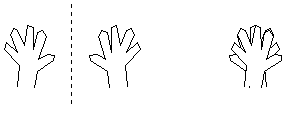Chirality is a property of molecules that can also be seen in many everyday objects. A molecule (or object) is said to be chiral if it cannot be superimposed upon its mirror image. A common example of a chiral object is the human hand (see Figure 1.) This is why sometimes chiral molecules are said to posess "handedness".


Organic molecules can be chiral if they possess one more more chiral carbon atoms. We will now see how to determine if a carbon atom, and hence the molecule containing the atom, is chiral.